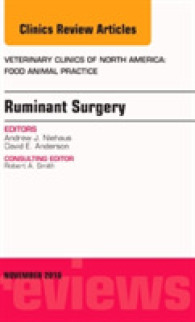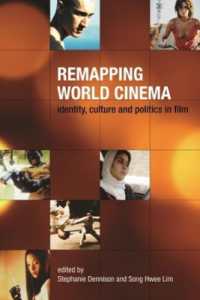Full Description
Envisioning a Critical and Liberatory Approach to Trans and Queer Center(ed) Diversity Work offers innovative and contemporary approaches for working with and for trans and queer (TQ) campus populations. By taking critical and liberatory perspectives, each chapter offers ideas that will inspire those called to serve TQ communities how to engage in practices to transform campuses, diversity work, and ourselves.
Through unabashedly critical, liberatory, and intersectional lenses, Catalano, Duran, Jourian, and Pryor and the chapter authors challenge readers to use this text to resist the oppression TQ lives face in higher education: "we must envision what we hope to transform our campuses into and use that vision as our compass" (Introduction). The editors have crafted a path toward a future already in progress; rich with insights, the book is accessible at all levels across higher education. It is a love letter that speaks with and to TQ center(ed) diversity work(ers), acknowledging the history and ongoing-ness of our struggle, while remembering that we will always be. This text is essential reading for those whose imaginations are bold enough to embrace it.
- D-L Stewart, Ph.D. Professor and Chair, Higher Education Department, University of Denver
There has never been a more urgent moment for Envisioning a Critical and Liberatory Approach to Trans and Queer Center(ed) Diversity Work. The editors bring together cutting-edge thinkers to address the nuances of TQ-centered diversity work across campus locations. As opposition to DEI intensifies, understanding the foundations presented here is critical for educators committed to equity for TQ students, staff, and faculty.
- Kristen Renn, Professor of Higher, Adult, & Lifelong Education, Mildred B. Erickson, Distinguished Chair Emerita Michigan State University
Catalano, Duran, Jourian, Pryor and their contributors have created a testament to the transformative power of education when grounded in liberation. It reminds us that transformative change is both possible and necessary, offering affirming pathways forward. Since our book in 2002, no comprehensive volume has explored LGBT student services or TQ-centered work with such depth. This is a must-read for scholar-practitioners, educators, and activists invested in institutional change.
- Sue Rankin, Retired Associate Professor of Education and Associate in the Center for the Study of Higher Education at the Pennsylvania State University
Thoughtful and creative scholarship on transgender identities in higher education has long been limited. This essential book champions critical, intersectional, and liberatory TQ-centered engagement, sparking imagination and offering support for the vital work being done on campuses. Congratulations to the editors for their insight and their passion as they move far beyond anything my colleagues and I could have envisioned decades ago.
- Ronni Sanlo, Playwright, author, and LGBT historian. Former director of the UCLA LGBT Center and professor in the UCLA Graduate School of Education
Grounded in historical context, this book is an indispensable guide to how TQ ideas, activism, and leadership have shaped equity work in higher education. It honors the courage, creativity, and persistence of those transforming educational policy and practice. It enlivens the work we do with lessons of the past, even as we envision liberatory futures. This book is an excellent roadmap to the home we dream of.
- Susan Marine, Ph.D., Professor, Merrimack College.
Contents
Acknowledgements
Introduction: Conceptualizing a Critical, Liberatory Approach to TQ Center(ed) Diversity Work — D. Chase J. Catalano, Antonio Duran, T.J. Jourian, and Jonathan T. Pryor
Part 1: Historical and Theoretical Foundations
Chapter 1: Histories, Foundations and Tensions of TQ Center(ed) Diversity Work — Roman Christiaens
Chapter 2: Frameworks to Guide TQ Center(ed) Diversity Work: Bridging Critical Theories with Practice — Antonio Duran and J. Audra Williams
Part 2: Present Realities
Chapter 3: Advocating for Equitable Policies for Trans and Queer Communities in Higher Education — Em C. Huang and Andy Cofino
Chapter 4: Engaging Institutional Politics through a Power Analysis in TQ Center(ed) Diversity Work — Vanessa Aviva Gonzàlez-Siegel
Chapter 5: Beyond Silos: Opportunities for Collaborations Across Student and Academic Affairs with TQ Center(ed) Diversity Workers — Chelsea E. Noble and Justin A. Gutzwa
Chapter 6: Rethinking Staffing and Hiring in TQ Center(ed) Diversity Work — R.B. Brooks and Tristan Crowell
Chapter 7: From "Safe" to Liberatory: A New Approach to Educating Campus Communities with TQ Center(ed) Diversity Workers — Kalyani Kannan and D. Chase J. Catalano
Chapter 8: Addressing Trans Oppression and Serving Trans Students within TQ Center(ed) Diversity Work —Alex C. Lange
Chapter 9: Who Said it Was Simple?: Reframing Difficulties and Failures of Supporting Trans and Queer People of Color (TQPOC) Students in TQ Center(ed) Diversity Work — Mycall Akeem Riley
Chapter 10: Attending to Ableism in TQ Center(ed) Diversity Work — Ryan A. Miller and Liz Elsen
Part 3: Visions for the Future
Chapter 11: Senior Leaders as Trans and Queer Advocates for TQ Center(ed) Diversity Work — Joshua Moon-Johnson
Chapter 12: TQ Center(ed) Diversity Work in Challenging Sociopolitical Environments — Kathleen Hobson and T.J. Jourian
Conclusion: Dreaming of Liberation & Solidarity: Notes for How We Keep Going — D. Chase J. Catalano and T.J. Jourian
Notes on Contributors








